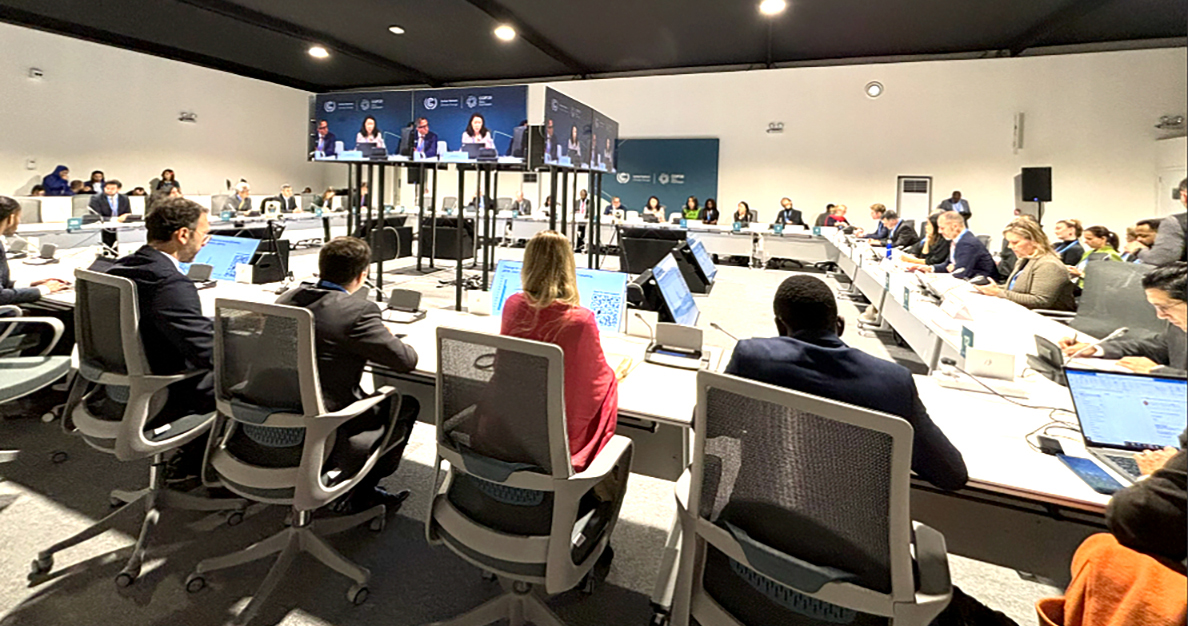Could trade tensions and U.S. policy uncertainty shift the eye of climate finance away from the world’s largest economy? That was the question at the center of a conversation hosted by the MSCI Sustainability Institute at London Climate Action Week that brought together leaders from finance and policymaking to explore the flow of climate capital in an age of fragmentation.
The conversation took place amid evidence suggesting the first significant shift of climate investment away from U.S. equities in at least seven years. Since the start of this year, the U.S. share in climate-themed funds has dropped by 10 percentage points, compared with a 3.1 percentage point decline in the weight of U.S. stocks within the MSCI ACWI Index, an analysis by the Institute finds. About half — roughly 6 percentage points — reflects active reallocation by climate funds toward companies in Europe and the Asia-Pacific region.
Held under Chatham House rule to encourage candor, representatives of institutions and organizations from the U.K., Europe, Asia, the Gulf region and the Americas discussed whether capital markets are witnessing a temporary rotation or the start of a more durable shift in the geography of climate capital. In opening remarks on the record, Ravi Menon, Singapore’s ambassador for climate action and former director of the Monetary Authority of Singapore, said that “precisely because the U.S. has stepped back, others have to step up.”
Here are some of the takeaways that stood out for us.
Key themes
- Owners and managers of assets differ in their views of the long term significance of recent U.S. policy shifts. But they agreed on many factors, including the increasingly competitive cost of clean technologies and growing demand for products and solutions that reinforce climate resilience, are creating opportunities globally.
- The U.S. withdrawal from global climate finance threatens to dent the availability public and development capital needed to incentivize private-sector investment, particularly in emerging economies.
- Market mechanisms, particularly initiatives to expand the availability of carbon trading, could play an increasingly pivotal role in driving climate finance for the global energy transition.
A difference of views among asset owners…
Sovereign and pensions funds expressed varied views of the possible effects of a U.S. pullback on clean technology investment. Several cited opportunities that are emerging globally regardless of U.S. policy, while others said they see a shift unlikely to impact investment transition technologies there.
Geographic exposure in climate funds %
Source: MSCI ESG Research, data based on asset-weighted exposures of 1,528 climate funds as of May 31, 2025.
- “Currently about 40% of our portfolio” is invested in the U.S. said one asset owner. “Barring a change that affects the trade relationship, we see a similar ratio even as we increase our investments in decarbonization.”
- “None of us want to see what’s going on in the states, but the U.K. government sees an opportunity to broadcast to the world that the U.K. is a safe and secure place to invest when it comes to the energy transition,” noted another.
- “With the scaling back of the Inflation Reduction Act, capital may be inclined to move elsewhere,” one asset owner added, citing opportunities outside the U.S., including in Asia and Africa, where renewable energy is increasingly affordable on a continent that has expensive energy. “You will see more renewable energy deployed in Africa in the next five years than you’ve seen in the last 30 years,” he added. “That’s a massive capital allocation opportunity that has not been recognized on a global scale.”
… and among asset managers
Institutional owners want to invest more in infrastructure and “private markets are at the top of that agenda,” said a global asset manager, adding that their firm also sees much more interest in investment in nuclear energy than it had previously.
Domiciles and destinations of climate funds by region (%)
Source: MSCI ESG Research, data based on asset-weighted exposures of 1,528 climate funds as of May 31, 2025.
- There may be a slowdown of climate investment in the U.S. but a replacement looks unlikely said one consultant. “Not just because incumbency takes a long time to shift but also there already is lot of investment in advanced projects in the U.S., political risks notwithstanding,” he said, adding that a rapid rise in the amount of capital allocated to clean technologies in Asia reflects “a recognition that the economics mean that such investments are no longer seen as climate projects but just good returns.”
- “We’re seeing secular trends aside from climate that might be moving investment from the U.S. toward emerging markets,” said another consultant, suggested that climate investing has begun to merge with strategic asset allocation.
- “Investors are looking for hedges against the U.S.” suggested one participant, pointing to Slovenia’s linking its interest payments on government bonds to climate targets as an example of available alternatives, as well as recent modeling by Norges Bank Investment Management suggesting that nearly one-fifth of the value of its U.S. equity holdings could be vulnerable to climate-related physical risk.
- A warming world means that growing demand for products and solutions that helps governments, businesses and consumers withstand the effects of climate change is likely to grow globally, including in the U.S., policy shifts notwithstanding, suggested one asset manager, citing the growth in data centers. “The power lines cannot catch fire, and hence these investments will ultimately incorporate adaptation and resilience,” he noted.
The bigger picture
A pending rollback of the Inflation Reduction Act is garnering attention but also tends to overshadow investment in the energy transition underway globally, noted participants. At the same time, a pullback in transition support by the U.S. could reduce the amount of capital available to incentivize private-sector investment, particularly in emerging economies.
Pure-play providers, year-over-year revenue growth (2019-2024, revenue-weighted)
Source: MSCI ESG Research, FactSet. Pure-play solutions providers are defined as those that earn more than 50% of their revenues from the identified low-carbon business lines based on the MSCI Sustainable Impact Metrics methodology, as of the latest assessed financial report. Low-carbon solutions providers (excluding pure players) are identified using a low threshold of 5% to include companies that are potentially transitioning and positioning for growth from the identified low-carbon business lines. Energy storage includes fuel cells and other energy storage solutions, such as battery energy storage. Green mobility includes zero emissions and hybrid vehicles and clean transport infrastructure (e.g., railway infrastructure). Low-carbon power includes renewable energy (solar, wind, wave tidal, small hydropower, geothermal, waste-to-energy and biomass) and nuclear power. Revenue growth is calculated in USD. Weights are derived using the average revenue of companies between 2019 and 2024. Winsorization of the average year-over-year growth rates was done at the 5th and 95th percentile to reduce the influence of extreme values.
- “A good part of the so-called headwinds that climate action is facing has to do with what’s happening in the U.S. and can impact on our sense of where things are, but I think we need to step back,” said Ambassador Menon. He noted that the European Union remains on course to meet most of its 2030 energy and climate targets and that governments in China, the U.K., Japan, Singapore, and South Korea are all acting to uphold decarbonization commitments.
- “The economics are driving toward decarbonization,” the ambassador continued, noting that in much of the world, renewable energy is cheaper than fossil fuels and that the market for electric vehicles may be more constrained by the need for charging infrastructure than the actual cost of EVs.
- At the same time, “financing the transition remains a challenge,” he noted, terming the withdrawal of the U.S. a setback, especially in light of the need to use public and development finance to attract private sector investment. “A lot of projects that you need to de-risk are just below bankability,” he stressed. “We can crowd in eight dollars of private sector investment for every public dollar.”
- The U.S. withdrawal “will leave a real hole in concessional finance in southeast Asia, Africa and Latin America,” agreed one participant. If anything, she stressed, there should be an increase in concessional finance, noting from experience that such structures translate to less risk and higher returns than investors tend to anticipate.
Market mechanisms matter
Market mechanisms, including carbon trading, matter for the flow of climate finance, added Ambassador Menon, who co-chairs a coalition formed by the governments of Kenya, Singapore and the U.K. to grow carbon markets by strengthening their integrity and interoperability.
- “Carbon markets are key for decarbonization in the Global South,” he observed. “These are the mechanisms we need to work on and scale to accelerate a just transition.”
- “Carbon removals are generating interest from buyers,” agreed another participant, citing continuing purchases of removals by U.S. tech giants and the trend by governments to link voluntary and compliance markets by permitting, as Singapore does, the use of high-quality carbon credits to offset a portion of their taxable emissions.
Institutions and organizations represented (partial list)
Anthropocene Fixed Income Institute
James Cameron & Co
Climate Policy Initiative
Climate Arc
CrossBoundary
CDPQ Global
D.A. Carlin and Company
Ember Futures
Future Fund
Institutional Investors Group on Climate Change (IIGCC)
JPMorgan
Khazanah Nasional Berhad
KAPSARC
The Lightsmith Group
McKinsey & Company
Mubadala
National Climate Change Secretariat of Singapore
Nigeria Sovereign Investment Authority
Norinchukin Bank
Rothschild & Co
SUN Group
Temasek
UK National Wealth Fund
Winrock International
World Wildlife Fund (WWF)


